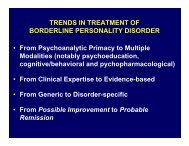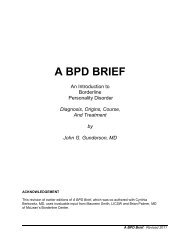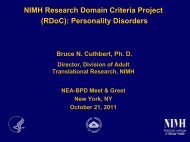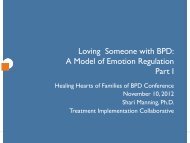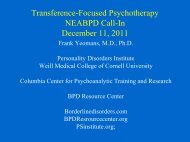Dr. Lois Choi-Kain - Borderline Personality Disorder
Dr. Lois Choi-Kain - Borderline Personality Disorder
Dr. Lois Choi-Kain - Borderline Personality Disorder
- No tags were found...
Create successful ePaper yourself
Turn your PDF publications into a flip-book with our unique Google optimized e-Paper software.
Thanks to• Anthony Bateman M.D. and PeterFonagy Ph.D.• Shauna Dowden Ph.D.
Mentalization: Definitions“ The mental process by which an individualimplicitly and explicitly interprets thethe actions of herself and others asmeaningful on the basis of intentionalmental states such as personal desires,needs, feelings, beliefs, and reasons.”Bateman A, Fonagy P (2004), Psychotherapy for <strong>Borderline</strong><strong>Personality</strong> <strong>Disorder</strong> - Mentalization-Based Treatment. Oxford, U.K.:Oxford University Press.
Mentalization: Two PeopleSELFFeelingsThoughtsMotivesIntentionsBeliefsDesiresNeedsOTHERFeelingsThoughtsMotivesIntentionsBeliefsDesiresNeeds
In Other Words: Dejargonified• To see ourselves from the outside and others fromthe inside• Understanding misunderstanding• Having mind in mind• Introspection for subjective self-construction – knowyourself as others know you but also know yoursubjective self (your experience)
Benefits of Mentalizing• Connection through shared understanding.• A “meeting of minds”.• Leads to better interpersonal functioning, andtherefore, better chance at getting objectives met inlife & relationships.• Being misunderstood is aversive, it can lead topainful emotions.• Many BPD difficulties can result from the temporaryloss of mentalizing.
Attachment, Mentalization, and BPD
Basic Attachment Theory• Two basic tenets of attachment theory (Bowlby):◦ Humans are born with a predisposition to become attached tocaregivers Instinctual enactment of behaviors to facilitate attachment Crying, smiling, clinging, cooing◦ Instability of attachment results in Insecurity=> inability to regulate, contain, modulate affect Disturbances in ability to explore and self-enhance Disturbances in future ability to sustain meaningful relationships
Attachment and<strong>Borderline</strong> <strong>Personality</strong> <strong>Disorder</strong>• BPD is associated with disorganized, preoccupied,and fearful attachment styles (Reviews see Agrawalet al., 2004 and Levy, 2005)• <strong>Borderline</strong> <strong>Personality</strong> <strong>Disorder</strong> is characterized bydisorganized, preoccupied attachment and lowReflective Function (mentalization) (Fonagy et al.,1996)
Attachment Functioning in BPDSelfOtherAttachment BidClingy, angry, passive,oscillatory.Confused, dissociated,conflicted, controlling.
Attachment Functioning in BPDSelfOtherInvolving, overprotective,inconsistent.Hostile, helpless, fearful,frightening.Caregiver Response
Models of Self and Other in Attachment(Bartholomew & Horowitz, 1991)Models of Self (dependence)Postive(low)Positive (low) Negative (high)SECUREPREOCCUPIEDModelsof Other(avoidance)Comfort with intimacyand autonomyDISMISSINGPreoccupied withrelationshipsFEARFULNegative(high)Dismissing of intimacyFearful of intimacySocially avoidant
Early and LateAttachmentCyclesINFANTBIDSRESPONSECAREGIVERSELFATTACHMENTSTYLEOTHER
Developmental ModelPsychological Self:2 nd OrderRepresentationsRepresentationof self-state:internalization ofobject imageSymbolic binding ofinternal stateExpression ofmetabolizedaffectMirroring DisplayMarkedExpressionReflectionPhysical Self: PrimaryRepresentationsConstitutional self inState of arousalsignalNon-verbalexpressionResonanceFonagy et al., 2002CHILDCAREGIVER
Problems of Attachment and MTZ in BPD• Intense, dependent, confused, controlling bids forattachment that does not re-regulate (and mightintensify distress)• Vacillatory (involved=>exhausted) and hostile,helpless, fearful caregiver responses• Mentalizing capacities go offline leading to beingeither overwhelmed or disconnected in perspectiveson interpersonal interactions• Prementalistic states lead to symptomatic activity(interpersonal instability, self-harm, impulsivity,dissociation, paranoia
Attachment, Mentalization, and BPD
Mentalizing Instabilities in BPD• BPD is defined as a problem of instability ofmentalizing◦ Individuals with BPD are often better at mentalizing thanothers at times, and under specific conditions, mentalizingfails Hyperactivated attachment (high distress, activating butineffective attachment bids) High affective intensity◦ When individuals with BPD are symptomatic, this is associatedwith mentalizing going “off-line”◦ Prementalistic states arise
• Psychic equivalence:◦ Mental reality = outer realityPrementalistic States◦ Experience of mind can be terrifying (flashbacks)◦ Intolerance of alternative perspectives (“I know what the solutionis and no one can tell me otherwise ”)◦ Self-related negative cognitions are TOO REAL! (feeling ofbadness felt with unbearable intensity)
Prementalistic States• Pretend mode:◦ Ideas form no bridge between inner and outer reality;mental world decoupled from external reality◦ Linked with emptiness, meaninglessness and dissociationin the wake of trauma◦ Lack of reality of internal experience permits selfmutilationand states of mind where continued existenceof mind no longer contingent on continued existence ofthe physical self◦ In therapy endless inconsequential talk of thoughts andfeelings The constitutional self is absent feelings do not accompanythoughts
• Teleological stance:Prementalistic States◦ Expectations of others are are formulated in concrete,purely observable terms◦ A focus on understanding actions in terms of theirphysical as opposed to mental outcomes◦ Only action that has physical impact is felt to be able toalter mental state in both self and other Physical acts (self-harm) communicate internal states Demand for acts of demonstration (of affection) by others
GeneticvulnerabilityPoor controlof attentionActivating (provoking)risk factors (emotional abuse,trauma, non-mentalizingsocial system)Inhibition or decouplingof social cognition(social misjudgements,paranoid thoughts,mentalizing failure)Poor affectregulationAttachment systemdisorganized bytrauma & stressHyper-reactiveattachmentsystemEarly attachmentenvironmentFragileinterpersonalunderstandingVulnerability riskfactorsRe-emergence ofpre-mentalistic modesof subjectivity(psychic equivalencepretend modeteleological thinkingFormation risk factors(interpersonal stress,experience of rejection)
Mentalization Based TreatmentFUNDAMENTALS OF TECHNIQUE
Tasks of Mentalizing Therapists• Monitoring mentalizing=> Intervene whenmentalizing goes offline• Monitor attachment=> regulate attachment so itsactivated but not too hyperactivated• Maintain mentalizing stance• Promote restoration of mentalizing
Managing the Attachment and MTZPsychological Self:2 nd OrderRepresentationsRepresentationof self-state:internalization ofobject imageSymbolic binding ofinternal stateExpression ofmetabolizedaffectMirroring DisplayMarkedExpressionReflectionPhysical Self: PrimaryRepresentationsConstitutional self inState of arousalsignalNon-verbalexpressionResonanceFonagy et al., 2002CHILDCAREGIVER
Mentalizing Therapist Stance• Not-Knowing, but Curious• Neither therapist nor patient experiencesinteractions other than impressionistically• Identify difference – ‘I can see how you get to thatbut when I think about it, it occurs to me that hemay have been pre-occupied with something ratherthan ignoring you because he hates you’.• Acceptance of different perspectives• Active questioning
Mentalizing Therapist Stance• Eschew your need to understand – do not feelunder obligation to understand the nonunderstandable.• Monitor you own mistakes• Model honesty and courage via acknowledgementof your own mistakes both in the moment and inthe future• Suggest that mistakes offer opportunities to re-visitto learn more about contexts, experiences, andfeelings
Mentalizing Therapist Stance• Empathic about how they are thinking andfeeling, getting them to describe is important• Cannot explore before empathy• Use not knowing what to say as clue thatsomething does not make sense and there issomething to be curious about• Curiosity about experience, probing aboutpatients experience serves to validate theexperience• Normalizing is component of moving totransference work – stating feelings in firstperson: “I would feel X, so surprised you appearnot to...”
Therapist’s Mind• Therapist continually questions his andpatient’s internal mental state:• What is happening now?• Why is the patient saying this now?• Why is the patient behaving like this?• Why am I feeling as I do now?• What has happened recently in thetherapy that may justify the currentstate?
Turning Your Thoughts Into Technique• Using questioning comments to promoteexploration• What do you make of what has happened?• Why do you think that he said that?• Perhaps you felt that I wasjudging/misunderstanding you?• Why do you think that he behaved towardsyou as he did?
Pearls about Using MTZ• Understand the nature of BPD symptoms asproblems of disorganized insecure attachment andunstable mentalization• Identify moments of lost mentalizing• Be curious and mentalize yourself and the individualwith BPD• Use marked and contingent mirroring to stabilize theattachment and facilitate mentalizing• Reflect on what happens when mentalizing isrestored
Resources• Bateman & Fonagy’s Mentalization-based Treatmentfor <strong>Borderline</strong> <strong>Personality</strong> <strong>Disorder</strong> (2006)• Bateman & Fonagy’s Handbook of Mentalizing inMental Health Practice (2011)• Allen, Fonagy, Bateman’s Mentalizing in ClinicalPractice (2008)
For further Information• Mentalization Based Treatment Intensive TrainingJanuary 2012: email Abredice@partners.org







